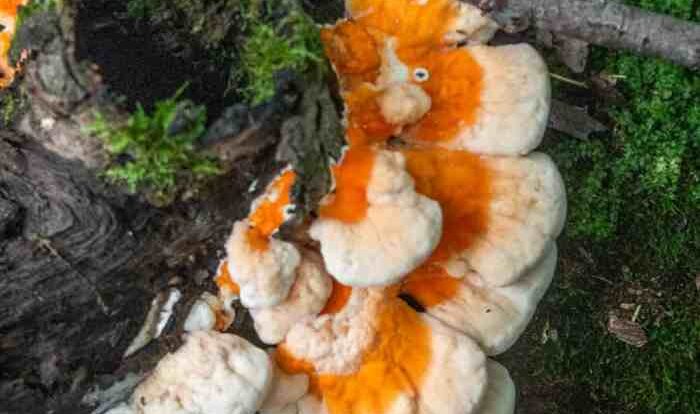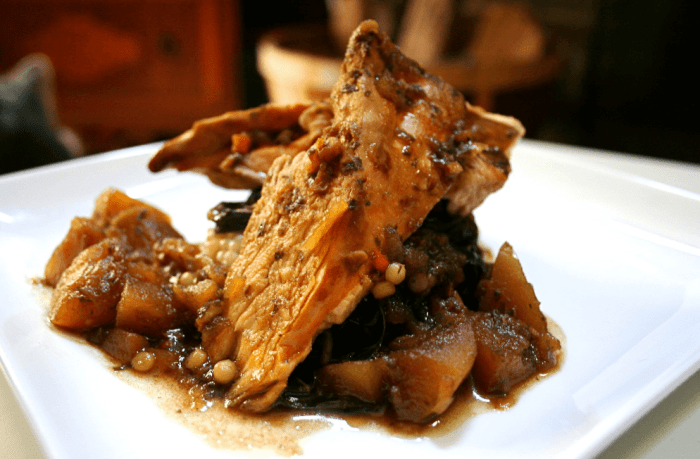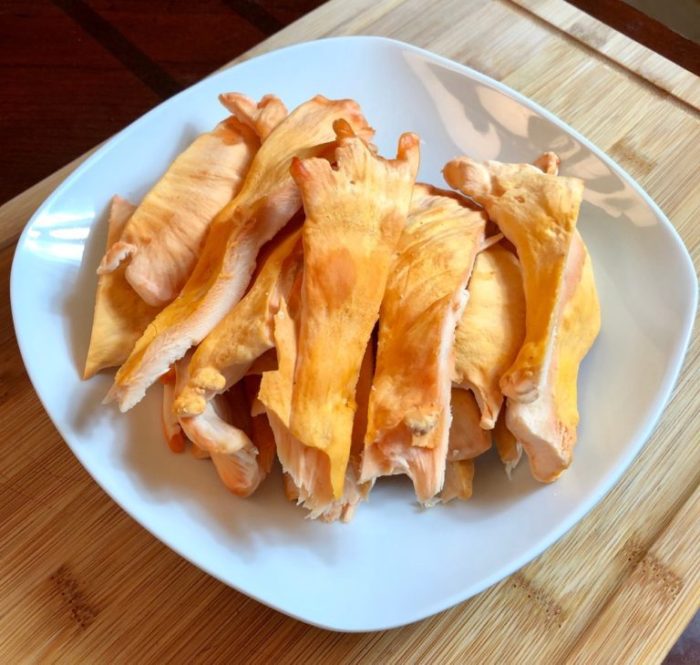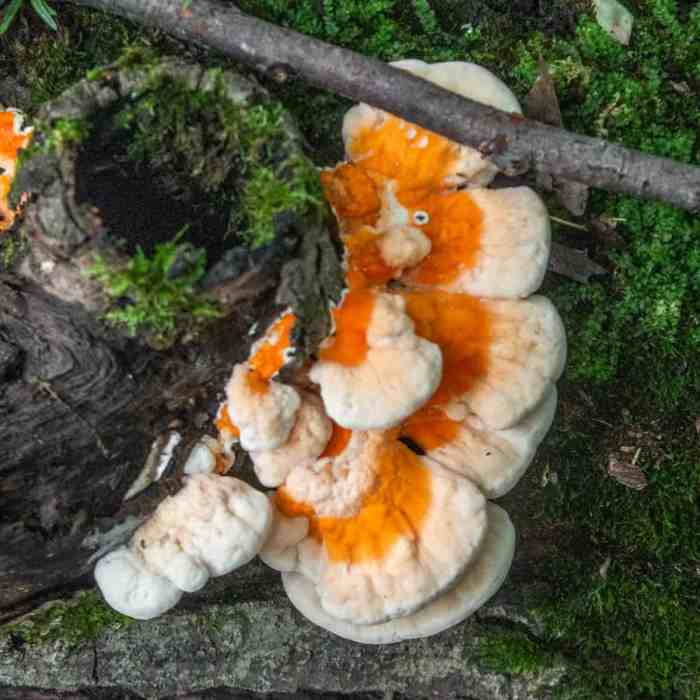
Chicken of the woods recipe – Prepare to delve into the tantalizing world of chicken of the woods, a wild mushroom renowned for its versatility and culinary delights. This comprehensive guide will lead you through every step, from identifying and harvesting to preparing and enjoying this delectable treat.
Chicken of the Woods Identification: Chicken Of The Woods Recipe

Chicken of the woods ( Laetiporus sulphureus) is a distinctive mushroom that is prized for its culinary value. It is a large, shelf-like mushroom that grows on the trunks of dead or dying hardwood trees. Chicken of the woods gets its name from its resemblance to chicken meat, both in texture and flavor.
If you’re looking for a delicious and unique dish, check out this chicken of the woods recipe . This edible mushroom has a meaty texture and a savory flavor, making it a great substitute for chicken. It’s perfect for stir-fries, soups, and even grilling.
Chicken of the woods is typically bright orange or yellow in color, with a velvety texture. It has a firm, meaty texture and a slightly sweet, nutty flavor. It is important to note that there are several other species of Laetiporusthat are similar in appearance to chicken of the woods, but not all of them are edible.
It is important to be able to distinguish between these species before consuming any wild mushrooms.
Identifying Chicken of the Woods
- Color:Chicken of the woods is typically bright orange or yellow, but it can also be white or pink.
- Texture:Chicken of the woods has a velvety texture, similar to chicken meat.
- Shape:Chicken of the woods is a shelf-like mushroom that grows on the trunks of trees.
- Size:Chicken of the woods can range in size from a few inches to over a foot in diameter.
- Habitat:Chicken of the woods grows on the trunks of dead or dying hardwood trees, especially oak trees.
Similar Species
There are several other species of Laetiporusthat are similar in appearance to chicken of the woods, but not all of them are edible. Some of the most common look-alikes include:
- False chicken of the woods (Laetiporus huroniensis): False chicken of the woods is a close relative of chicken of the woods, but it is not as common. It is typically a paler color than chicken of the woods, and it has a more bitter flavor.
- Sulphur shelf (Laetiporus sulphureusvar. sulphureus): Sulphur shelf is a close relative of chicken of the woods, but it is typically smaller and more orange in color. It has a more bitter flavor than chicken of the woods.
- Red-banded polypore (Fomitopsis pinicola): Red-banded polypore is a common mushroom that is often mistaken for chicken of the woods. It is typically a darker color than chicken of the woods, and it has a red band around its edge.
It is important to be able to distinguish between these species before consuming any wild mushrooms. If you are not sure whether or not a mushroom is edible, it is best to err on the side of caution and avoid eating it.
Harvesting and Cleaning Chicken of the Woods

Chicken of the Woods is a delicious and versatile mushroom that can be found in many parts of the world. It is best harvested in the late summer and fall when it is at its peak flavor. When harvesting, look for mushrooms that are firm and have a bright orange color.
Avoid mushrooms that are slimy or have any signs of decay.To harvest Chicken of the Woods, simply cut it off the tree trunk at the base. Be careful not to damage the mushroom or the tree. Once you have harvested the mushroom, clean it by brushing off any dirt or debris.
You can also rinse the mushroom under cold water if necessary.
Culinary Applications of Chicken of the Woods

Chicken of the woods is a versatile culinary mushroom that can be enjoyed in various dishes. Its meaty texture and mild flavor make it a suitable ingredient for soups, stews, salads, and more. The cooking method can significantly impact the flavor and texture of the mushroom, allowing for customization to personal preferences.
Cooking Methods
- Sautéing:Sautéing chicken of the woods in butter or oil brings out its savory flavor and creates a slightly crispy exterior.
- Roasting:Roasting in the oven caramelizes the mushrooms, intensifying their sweetness and creating a tender texture.
- Grilling:Grilling imparts a smoky flavor to the mushrooms, making them perfect for outdoor cooking.
- Frying:Frying chicken of the woods in a tempura batter creates a crispy and flavorful treat.
Preparing for Different Dishes
Preparing chicken of the woods for different dishes requires specific techniques.
Soups and Stews
For soups and stews, the mushrooms should be cleaned and cut into bite-sized pieces. Sautéing them lightly before adding them to the liquid base enhances their flavor.
Salads
In salads, raw or cooked chicken of the woods can be used. Raw mushrooms add a crunchy texture, while cooked mushrooms provide a softer bite.
Nutritional Value and Health Benefits
Chicken of the woods is a nutritionally dense mushroom, rich in vitamins, minerals, and antioxidants. It is a good source of fiber, protein, and essential amino acids, making it a valuable addition to a plant-based diet.
Vitamin and Mineral Content
- Vitamin C: A powerful antioxidant that supports immune function and collagen production.
- Vitamin B3 (Niacin): Important for energy metabolism and nerve function.
- Vitamin D: Essential for bone health and immune system regulation.
- Potassium: An electrolyte that helps regulate blood pressure and muscle function.
- Iron: A mineral necessary for oxygen transport and red blood cell production.
Antioxidant Content
Chicken of the woods is a rich source of antioxidants, including:
- Ergothioneine: A powerful antioxidant that protects cells from damage.
- Glutathione: An antioxidant that helps detoxify the body and protect against oxidative stress.
- Phenolic compounds: Antioxidants that have anti-inflammatory and antimicrobial properties.
Health Benefits
Consuming chicken of the woods has been linked to several potential health benefits, including:
- Immune system support: Due to its high vitamin C and antioxidant content.
- Anti-inflammatory properties: Attributed to its phenolic compounds.
- Reduced risk of chronic diseases: Due to its antioxidant and anti-inflammatory effects.
Comparison to Other Mushrooms and Plant-Based Foods
Compared to other mushrooms, chicken of the woods is a good source of protein, fiber, and essential vitamins and minerals. It is also a good source of antioxidants compared to many plant-based foods. However, it is important to note that different mushrooms and plant-based foods have varying nutritional profiles, so it is beneficial to incorporate a variety into your diet.
Pairing and Accompaniments

Chicken of the woods is a versatile mushroom that pairs well with various ingredients and flavors. Its meaty texture and slightly nutty flavor make it a great addition to a wide range of dishes.
When cooking chicken of the woods, consider enhancing its taste with complementary ingredients. Aromatic herbs like thyme, rosemary, and sage add a touch of earthy goodness. Spices such as paprika, cumin, and chili powder bring warmth and depth of flavor.
A squeeze of lemon or a splash of white wine adds a refreshing brightness.
Sauces, Marinades, and Rubs
To further elevate the flavor of chicken of the woods, consider using sauces, marinades, or rubs. A simple butter sauce made with garlic and herbs can enhance the mushroom’s natural flavors. For a more robust taste, try marinating the mushrooms in a mixture of olive oil, balsamic vinegar, and herbs overnight before grilling or roasting.
Alternatively, a dry rub made with paprika, garlic powder, and onion powder can add a savory crust to the mushrooms.
Side Dishes and Accompaniments, Chicken of the woods recipe
Chicken of the woods pairs well with a variety of side dishes and accompaniments. Roasted vegetables such as carrots, parsnips, and Brussels sprouts complement the earthy flavors of the mushrooms. Creamy polenta or mashed potatoes provide a rich and comforting base.
For a lighter accompaniment, try a fresh salad with greens, tomatoes, and a tangy vinaigrette.
Epilogue

As we conclude our culinary exploration of chicken of the woods, remember that this wild mushroom offers a unique and flavorful addition to any dish. Its nutritional benefits and culinary versatility make it a must-try for both experienced and aspiring chefs.
So gather your ingredients, embrace the adventure, and savor the taste of nature’s bounty.
FAQ Compilation
What are the key characteristics of chicken of the woods?
Chicken of the woods is characterized by its bright orange to yellow color, cauliflower-like shape, and meaty texture.
When is the best time to harvest chicken of the woods?
Late summer and early fall are the ideal times to harvest chicken of the woods, when it is at its peak of flavor and abundance.
How can I incorporate chicken of the woods into my diet?
Chicken of the woods can be cooked in a variety of ways, including sautéing, grilling, and roasting. It pairs well with hearty flavors and can be added to soups, stews, and salads.





